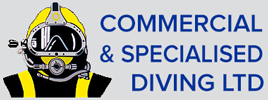There are several ways to communicate to a diver underwater, however, the communications used by commercial divers are embedded within their air delivery hose system called an umbilical. The umbilical also doubles as a lifeline.

The umbilical feeds breathing air and communications from the surface to the diver. This allows 2-way communication to take place. If there is more than one diver in the water it can also allow for diver to diver communication, controlled from the surface.

Commercial & Specialised Diving have over 20 years’ experience conducting diving work and understand that underwater communication is essential to make jobs run smoothly. Risk assessments and pre dive briefings are used to ensure divers know what to do in the unlikely event of a communications failure.
Commercial & Specialised Diving have an in-company policy of checking all communications equipment before it is sent out onto a job. We have an exemplary safety record and ensure all of our equipment is in good working order.
Having the communications hard wired to the diver ensures reliable communication, but there are several ways that the cable can fail if the equipment is not maintained to a high standard.
If the cable protective sheath becomes damaged, water can ingress and corrode the copper wire inside. Repetitive strain on the cable can also cause the cable to become weak, causing failure.
So what happens if the communications fail?
There are 2 types of communication failure:
Partial failure
With partial failure it may be that the diver can still hear the communications from the surface or that the surface can still hear the diver.
Complete Failure
With complete failure no communication can be sent or received from either the diver or the surface.
Response
The response to any communications failure is to resort to use predetermined rope signals using the umbilical. Commercial & Specialised Diving ensure that our divers are trained to the highest standards to ensure these signals can be used on a lifeline, communication rope or umbilical.
It is important that for rope signals to work that the diver will ensures their umbilical is not snagged or wrapped around any underwater obstacles.
An attention signal is used first to ensure the diver and tender are ready to send and receive signals.
The tender will take up any slack until he can feel the diver on the end. The diver and tender can then feel the rope signals down the taught umbilical. The tender will also carefully watch the diver’s bubbles to ensure they are breathing normally.
At the end of the dive the diver can be given 4 pulls, to signal for him to come up.

Commercial & Specialised Diving have achieved an exemplary Health and Safety track record due to our high standards of maintenance, competence and well trained divers. Commercial & Specialised Diving have never had to use emergency communication procedures and have a zero expectation of an emergency ever occurring.
Commercial & Specialised Diving have the ability to risk assess, manage and deal with any diving emergency situation.
When choosing a diving contractor, one should always look at their Health and Safety record, risk mitigation and crisis capability including emergency action procedures.
Commercial & Specialised Diving are experience commercial diving contractors who work nationwide. Contact our sales team to find out more at sales@specialised-diving.co.uk or 01202 580007.

